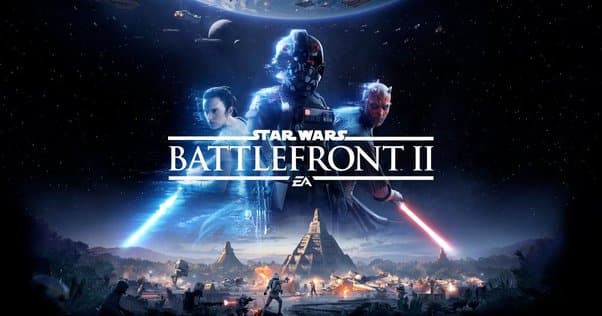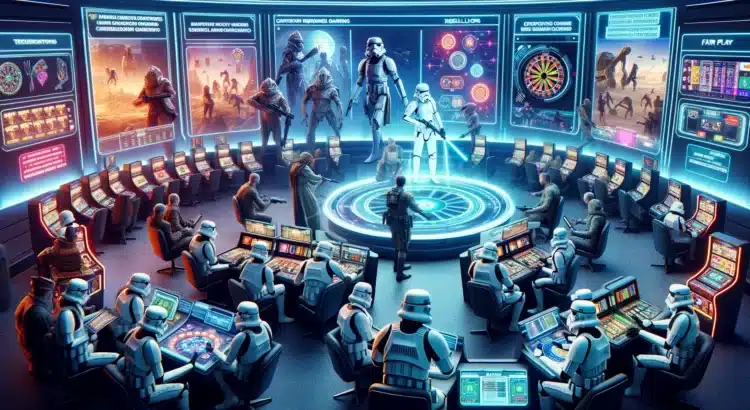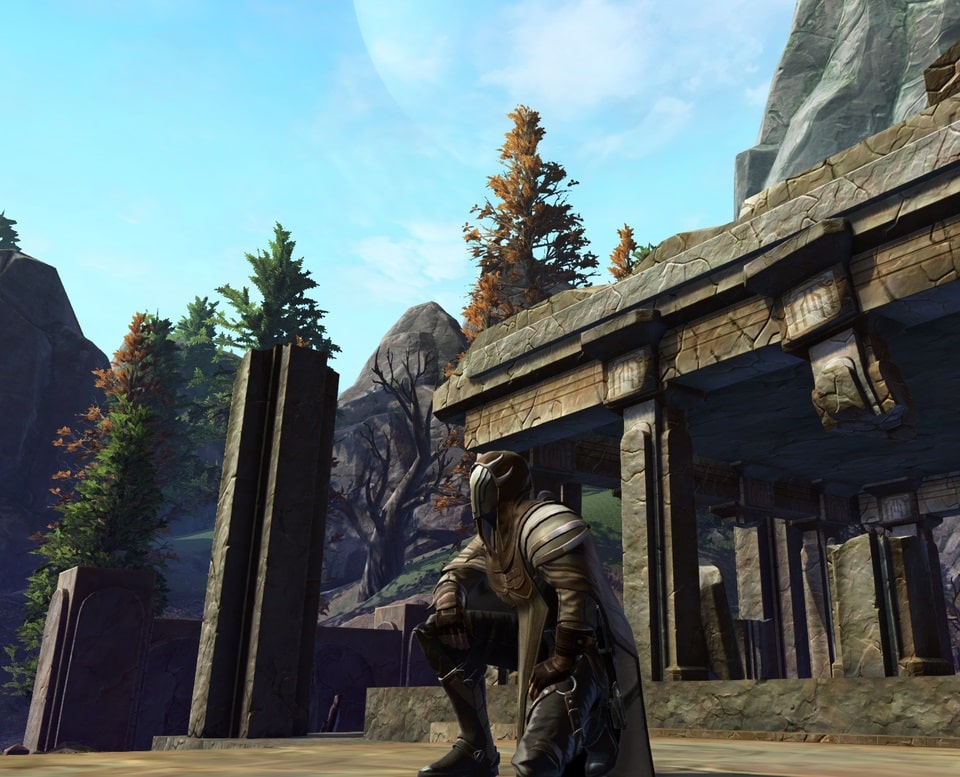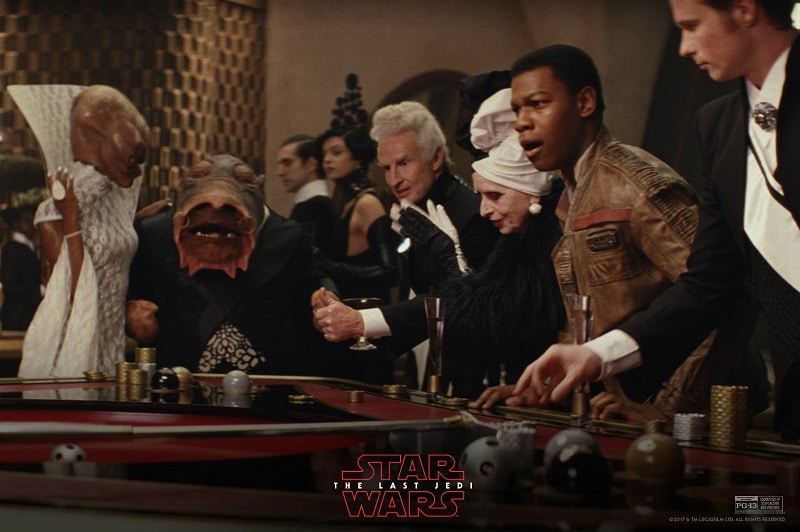The integration of gambling-like mechanisms in video games has become a hot-button issue in the gaming industry, leading to various responses from regulatory bodies worldwide. This trend has especially come under scrutiny when popular franchises like Star Wars include these elements in their titles. The purpose of this article is to explore how different regions and regulatory entities have addressed the convergence of gaming and gambling, focusing on case studies from the Star Wars franchise. Here’s what we’ll cover:
- The Emergence of In-Game Gambling Elements: Understanding how gambling-like features, particularly loot boxes, have become prevalent in modern video games.
- Star Wars Battlefront II – A Turning Point: Examining how this specific Star Wars title brought the issue of in-game gambling elements to the forefront, sparking widespread controversy and debate.
- Global Regulatory Landscape: Analyzing the varying responses from regulatory bodies in key regions like the United States, the European Union, Australia, and Asia.
- The Response of the Gaming Industry and Community: Looking at how the gaming industry, including developers like Electronic Arts (EA), and the gaming community have reacted to these regulatory challenges.
- The Future of In-Game Gambling Regulation: Discussing the ongoing debate and what the future might hold for the regulation of gambling-like elements in video games.
The intersection between gaming and gambling is a complex and multifaceted issue. By examining how it’s been handled in various contexts, particularly with a focus on the Star Wars franchise, we can gain a deeper understanding of the current state of play and the potential paths forward in the regulation of video games.
The Rise of In-Game Gambling Elements
The landscape of video gaming has undergone a significant transformation in the past few years, with one of the most notable changes being the integration of gambling-like elements into mainstream titles. This section delves deeper into the emergence and rise of these features, particularly focusing on how they have become a staple in modern gaming experiences.
- Introduction of Loot Boxes: The concept of loot boxes is central to the discussion of in-game gambling. These virtual containers, which can be purchased with real or in-game currency, offer players randomized rewards. The chance-based nature of these rewards is what draws parallels to gambling, as players often cannot predict or influence the outcome of their investment.
- The Appeal of Loot Boxes: From a business standpoint, loot boxes represent a lucrative revenue model for game developers. They tap into the player’s desire for rare in-game items or cosmetics, creating a continuous revenue stream post-purchase. This model, known as microtransactions, has become increasingly common in both free-to-play and full-priced games.
- Psychological Impact: The mechanics of loot boxes have raised concerns due to their resemblance to gambling. The thrill of opening a loot box is similar to the anticipation of a gamble, potentially triggering the same psychological responses. This has sparked a debate about the ethical implications of these features, especially regarding their impact on younger players who might be more susceptible to addictive behaviors.
- The Role of Chance and Skill: Another aspect fueling the debate is the thin line between skill-based rewards and those purely based on chance. While some games reward players based on their performance, others rely solely on chance when dispensing loot boxes, intensifying the gambling parallels.
- Community and Media Response: The integration of these elements has not gone unnoticed by the gaming community and the media. High-profile cases, particularly involving popular franchises like Star Wars, have led to significant backlash from players and scrutiny from journalists, bringing the issue into the public eye.
- Regulatory Attention: The growing concern over loot boxes has caught the attention of regulatory bodies. Questions about whether these mechanics constitute gambling and if they should be regulated as such have become increasingly prevalent. This has led to a global conversation about the need for stricter oversight of in-game monetization practices.
The rise of in-game gambling elements, exemplified by loot boxes, represents a critical juncture in the evolution of video gaming. As these features become more ingrained in the gaming experience, the industry faces a challenge in balancing profitability with ethical gaming practices and consumer protection. This issue has led to a broader discussion on the nature of video games and their intersection with gambling, setting the stage for the various regulatory responses explored further in this article.

Case Study: Star Wars Battlefront II
Star Wars Battlefront II, developed by Electronic Arts (EA), serves as a pivotal case study in the ongoing debate about in-game gambling elements. This title, part of the immensely popular Star Wars franchise, became a flashpoint in the controversy surrounding loot boxes and microtransactions.
- Initial Release and Backlash: Upon its release in 2017, Star Wars Battlefront II faced immediate backlash due to its heavy reliance on loot boxes. These loot boxes were not merely cosmetic; they contained items that significantly impacted gameplay, such as powerful character upgrades and abilities. This ‘pay-to-win’ model meant that players could potentially gain significant advantages in the game by spending real money, sparking accusations of unfairness and predatory practices.
- The Role of Loot Boxes: The game initially allowed players to purchase loot boxes with real-world money, offering randomized chances to win items that could influence game outcomes. This mechanism drew ire for resembling gambling, as players would invest money without a guarantee of receiving items of value, and for potentially giving paying players an unfair advantage over those who did not spend extra money.
- Community Outcry: The backlash was swift and vocal, with players and critics expressing their discontent online. The controversy was not limited to the gaming community; it caught the attention of mainstream media and regulators, leading to a global discussion about the ethics of such monetization strategies in video games.
- Regulatory Scrutiny: The controversy surrounding Star Wars Battlefront II brought the issue of loot boxes to the attention of lawmakers and regulators around the world. In some countries, this led to investigations into whether these mechanics constituted a form of gambling. This scrutiny played a significant role in shaping the policies and regulations regarding loot boxes in various regions.
- Electronic Arts’ Response: Faced with growing criticism, EA made the decision to temporarily disable all microtransactions in the game just before its official launch. This move was seen as a direct response to the negative reception from the community and the increasing concerns from regulators. Later, the game reintroduced microtransactions, but limited them to cosmetic items, thereby removing the pay-to-win aspect.
- Long-Term Impact on the Gaming Industry: The situation with Star Wars Battlefront II had far-reaching consequences beyond the game itself. It sparked a broader debate about the ethics of loot boxes and microtransactions in the gaming industry, leading many game developers and publishers to reconsider their in-game monetization strategies.
- Player Engagement and Game Reputation: The controversy also had a lasting impact on the game’s reputation and player engagement. Despite subsequent changes and improvements, Star Wars Battlefront II’s initial rollout is often cited as a cautionary tale about the risks of aggressive monetization strategies in video games.
The case of Star Wars Battlefront II highlights the complex interplay between game design, player experience, monetization strategies, and regulatory considerations. It underscores the importance of ethical considerations in game development, especially in titles that are part of beloved franchises. This case study serves as a significant reference point in discussions about the future of in-game monetization and its regulation.
Global Regulatory Responses
The controversy around in-game gambling elements, exemplified by titles like Star Wars Battlefront II, has prompted varied responses from regulatory bodies across the globe. The regulatory landscape is a patchwork of differing approaches and legislations, reflecting the complex nature of integrating gambling-like mechanisms in video games. Let’s explore how some key regions have responded:
- United States: In the U.S., the response has largely been at the state level, with several states proposing or considering legislation aimed at regulating or banning the sale of loot boxes to minors. For instance, Hawaii and California have seen lawmakers push for bills to regulate these practices. However, there has not yet been a comprehensive federal law specifically addressing loot boxes, leaving a largely fragmented regulatory environment.
- European Union: The EU has seen a more proactive and unified response. Notably, Belgium and the Netherlands have led the charge, with their gambling commissions classifying certain types of loot boxes as gambling. This classification led to games like Star Wars Battlefront II removing or modifying these features in these countries. In contrast, other EU countries are still in the process of defining their legal stance on these issues, reflecting the complexity and evolving nature of the subject.
- United Kingdom: The UK initially did not classify loot boxes as gambling but has since launched inquiries and called for evidence to understand the impact of these features. This move indicates a potential shift in the regulatory approach towards stricter oversight.
- Australia: The Australian government has shown concern about the risks associated with loot boxes. Following an inquiry by the Australian Senate, there have been discussions and recommendations for tighter regulations, though specific legislation has not been enacted yet. The discourse in Australia reflects a growing awareness and concern over the potential impact of gambling-like elements in video games.
- Asia: Countries in Asia have varied responses. Japan has had regulations on gacha (loot box-like mechanisms) for years, focusing on transparency and fairness. China, on the other hand, has implemented stringent regulations, mandating games to disclose the odds of winning items in loot boxes and imposing limits on purchases to curb excessive spending.
- Canada: Canadian authorities have been relatively quiet on the issue, with no specific legislation targeting loot boxes. However, there has been an increasing public and academic discourse, suggesting that regulatory measures might be considered in the future.
- International Collaborations and Discussions: There has been an increase in international collaboration and discussion regarding the regulation of in-game gambling elements. Various countries’ regulatory bodies are in dialogue, sharing best practices and insights to develop a more cohesive approach to this global issue.
The global regulatory response to in-game gambling elements is a testament to the growing recognition of the potential risks and ethical considerations involved. While there is no one-size-fits-all solution, the ongoing discussions and actions taken by different countries reflect a collective effort to address the challenges posed by these gaming mechanisms. As the industry continues to evolve, it is likely that regulatory approaches will also adapt, shaping the future landscape of video game development and monetization.
Industry and Community Response
The industry’s and gaming community’s reactions to the controversy surrounding in-game gambling elements, particularly in titles like Star Wars Battlefront II, have been multifaceted and significant. These responses highlight the complex relationship between game developers, players, and the evolving nature of game monetization.
- Immediate Backlash and Boycotts: The implementation of gambling-like elements in Star Wars Battlefront II led to immediate backlash from the gaming community. Players voiced their discontent on social media, forums, and through direct feedback to the developers. This outcry wasn’t just limited to vocal displeasure; it also manifested in organized boycotts and campaigns urging players not to purchase the game or its microtransactions.
- Electronic Arts’ (EA) Response: In response to the backlash, EA initially suspended and then significantly overhauled the microtransaction system in Star Wars Battlefront II. This reaction marked a notable instance of a major game developer altering a game’s core monetization mechanics post-launch due to community feedback.
- Changing Game Development Practices: The controversy has led to broader introspection within the industry. Developers and publishers are increasingly cautious about the incorporation of loot boxes and other gambling-like mechanics in their games. Many are opting for more transparent and player-friendly approaches, emphasizing cosmetic items that do not affect gameplay.
- Increased Transparency: One of the direct outcomes of the loot box controversy has been an increased emphasis on transparency from game developers. Companies are now more likely to disclose the odds of receiving items from loot boxes, a practice akin to regulations in the gambling industry.
- Community Vigilance: The gaming community has become more vigilant and vocal about in-game monetization practices. There’s a growing trend of players scrutinizing new titles for fair play and ethical monetization, reflecting a more empowered and informed consumer base.
- Influencers and Media’s Role: Gaming influencers and media played a significant role in amplifying the concerns regarding in-game gambling elements. Their coverage and critique of games like Star Wars Battlefront II have been instrumental in bringing these issues to a broader audience and putting pressure on developers and publishers.
- Academic and Research Interest: The issue has also caught the attention of academics and researchers, leading to numerous studies on the impact of gambling-like mechanics in games. This research is crucial in informing both industry practices and regulatory policies.
- Long-Term Industry Implications: The widespread response to the gambling-like elements in games has long-term implications for the gaming industry. It underscores the need for ethical considerations in game design and a balance between profitability and player welfare.
The response from the industry and the gaming community to the incorporation of in-game gambling elements highlights a pivotal moment in the evolution of game development and player engagement. It demonstrates a growing awareness and responsiveness to ethical considerations in gaming, signaling a shift towards more player-centric and transparent practices in the industry.
The Future of Regulation
The ongoing debate and varied responses to in-game gambling elements, exemplified by games like Star Wars Battlefront II, have set the stage for an evolving regulatory landscape. The future of regulation in this area is likely to be shaped by a confluence of industry practices, legal frameworks, technological advancements, and community expectations.
- Evolving Legal Definitions: A key aspect of future regulation will involve the evolving legal definitions of what constitutes gambling within a gaming context. As legislators and regulatory bodies grapple with how to categorize and manage loot boxes and similar mechanisms, we may see new definitions and categories emerge that better fit the unique nature of these digital products.
- International Collaboration and Standardization: Given the global nature of the gaming industry, there’s a growing need for international collaboration and standardization in regulations. Efforts may be directed towards establishing common guidelines and practices that can be adopted across different jurisdictions, helping to create a more consistent regulatory environment.
- Industry Self-Regulation: In response to the growing scrutiny, there may be an increased push towards self-regulation within the gaming industry. This could involve the adoption of standard codes of conduct, self-imposed restrictions on in-game monetization, and the establishment of industry-led regulatory bodies.
- Enhanced Transparency and Consumer Protection: Future regulations are likely to emphasize enhanced transparency, particularly in terms of the odds of winning items in loot boxes, and ensuring that consumers, especially minors, are adequately protected. This could lead to stricter age verification processes and clearer information being provided to players before purchase.
- Technological Solutions: As technology continues to advance, we may see the development of new tools and systems designed to monitor and regulate in-game gambling elements. This could include software that tracks spending habits or flags potentially addictive behavior, providing both developers and regulators with valuable data.
- Impact of Public Opinion and Research: Public opinion and ongoing research into the effects of in-game gambling will continue to influence regulatory developments. As more is understood about the psychological impact of these mechanics, particularly on young and vulnerable players, it is likely to inform more targeted and effective regulations.
- Balancing Innovation with Regulation: A major challenge for future regulation will be finding the right balance between protecting consumers and not stifling innovation within the gaming industry. Regulators will need to work closely with developers to ensure that new rules do not hinder creative game design or the economic viability of the gaming sector.
- Adapting to New Gaming Trends: The gaming industry is continuously evolving, with new trends and technologies emerging regularly. Future regulations will need to be adaptable and flexible to accommodate these changes, such as the rise of virtual and augmented reality gaming, blockchain-based games, and other innovations.
In conclusion, the future of regulation in the context of in-game gambling elements is poised to be dynamic and multifaceted. As the industry evolves, so too will the strategies and policies aimed at ensuring fair play, consumer protection, and ethical game design. It will require ongoing dialogue and cooperation between regulators, game developers, players, and other stakeholders to navigate this complex and rapidly changing landscape.
Frequently Asked Questions about In-Game Gambling and Regulation
- What is in-game gambling? In-game gambling refers to features in video games that resemble gambling, like loot boxes, where players can spend real or in-game currency for a chance to win virtual items.
- Why is Star Wars Battlefront II often mentioned in this context? Star Wars Battlefront II is a key example due to its initial use of loot boxes that affected gameplay, leading to significant controversy and discussions about in-game gambling.
- How have different countries responded to in-game gambling? Responses vary: some countries like Belgium have classified certain loot boxes as gambling, while others are still evaluating their legal stance or have taken no specific action yet.
- Are loot boxes considered illegal? The legality of loot boxes depends on the country’s laws. In some places, they are regulated as gambling, while in others, they are not subject to specific gambling laws.
- What changes have game developers made in response to the controversy? Many developers, including EA with Star Wars Battlefront II, have altered or removed loot boxes from their games, focusing more on cosmetic items and transparency.
- Is there a global standard for regulating in-game gambling? Currently, there is no global standard; regulations vary significantly by country. However, there’s a growing trend towards international dialogue and standardization.
- Can in-game gambling affect players psychologically? Yes, there are concerns that in-game gambling, especially through loot boxes, can mimic the psychological effects of gambling and potentially lead to addictive behaviors.
- Are there any age restrictions for games with gambling elements? Age restrictions depend on regional ratings and the nature of the game. Games with explicit gambling elements often have higher age ratings.
- What is the future of regulation for in-game gambling? The future likely involves more standardized regulations, increased transparency, industry self-regulation, and a balance between consumer protection and innovation.
- How can I stay informed about the regulation of in-game gambling? Staying updated through gaming news platforms, regulatory body announcements, and participating in community discussions are effective ways to stay informed.






